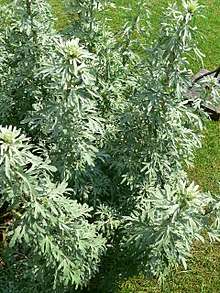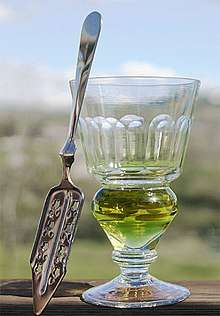Artemisia absinthium
Artemisia absinthium (wormwood, grand wormwood, absinthe, absinthium, absinthe wormwood[4]) is a species of Artemisia native to temperate regions of Eurasia[5] and Northern Africa and widely naturalized in Canada and the northern United States.[6] It is grown as an ornamental plant and is used as an ingredient in the spirit absinthe as well as some other alcoholic beverages.
| Artemisia absinthium | |
|---|---|
 | |
| Artemisia absinthium growing wild in the Caucasus | |
| Scientific classification | |
| Kingdom: | Plantae |
| Clade: | Tracheophytes |
| Clade: | Angiosperms |
| Clade: | Eudicots |
| Clade: | Asterids |
| Order: | Asterales |
| Family: | Asteraceae |
| Genus: | Artemisia |
| Species: | A. absinthium |
| Binomial name | |
| Artemisia absinthium | |
| Synonyms[2][3] | |
| |
Description
Artemisia absinthium is a herbaceous perennial plant with fibrous roots. The stems are straight, growing to 0.8–1.2 metres (2 ft 7 in–3 ft 11 in) (sometimes even over 1.5 m, but rarely) tall, grooved, branched, and silvery-green. The leaves are spirally arranged, greenish-grey above and white below, covered with silky silvery-white trichomes, and bearing minute oil-producing glands; the basal leaves are up to 250 mm (9.8 in) long, bipinnate to tripinnate with long petioles, with the cauline leaves (those on the stem) smaller, 50–100 mm (2.0–3.9 in) long, less divided, and with short petioles; the uppermost leaves can be both simple and sessile (without a petiole). Its flowers are pale yellow, tubular, and clustered in spherical bent-down heads (capitula), which are in turn clustered in leafy and branched panicles. Flowering is from early summer to early autumn; pollination is anemophilous. The fruit is a small achene; seed dispersal is by gravity.[6]
It grows naturally on uncultivated arid ground, on rocky slopes, and at the edge of footpaths and fields. Although once relatively common, it is becoming increasingly rare in the UK where it has recently been suggested that it is an archaeophyte rather than a true native.[7]
Cultivation
The plant can easily be cultivated in dry soil. It should be planted under bright exposure in fertile, mid-weight soil. It prefers soil rich in nitrogen. It can be propagated by ripened cuttings taken in spring or autumn in temperate climates, or by seeds in nursery beds. A common consideration applies to growing the plant with others as it tends to stunt their growth; accordingly it is not considered to be a good companion plant. A. absinthium also self-seeds generously. It is naturalised in some areas away from its native range, including much of North America and Kashmir Valley of India.[8]
This plant,[9] and its cultivars 'Lambrook Mist'[9] and 'Lambrook Silver'[10] have gained the Royal Horticultural Society's Award of Garden Merit. These two short cultivars are very similar and more silver than typical British absinthium material and probably derive from southern Europe. 'Lambrook Silver' is the earliest of these cultivars having been selected in the late 1950s by Margery Fish who developed the garden at East Lambrook Manor. 'Lambrook Mist' was selected about 30 years later by Andrew Norton, a subsequent owner of the garden. Both gained their AGMs (Award of Garden Merit) during the RHS Artemisia Trial 1991–3.
Cultivar 'Silver Ghost' is a taller silver plant which flowers much later (August – September) than typical absinthium (June – July) in UK and therefore holds its silver appearance for longer. This and a more feathery leaved cultivar 'Persian Lace' were selected by National Collection Holder John Twibell in the 1990s.[11]
Constituents
Wormwood herb contains bitter substances from the group of sesquiterpene lactones, Absinthin is with 0.2 to 0.28% the main component of these bitter substances. Essential oils make up 0.2 to 0.8% and contain (-) - thujone, (+) - isothujone, thujyl alcohol and its esters, chamazulene and other mono- and sesquiterpenes.[12][13]
Uses
It is an ingredient in the spirit absinthe, and is used for flavouring in some other spirits and wines, including bitters, bäsk, vermouth and pelinkovac. As medicine, it is used for dyspepsia, as a bitter to counteract poor appetite, for various infectious diseases, Crohn's disease, and IgA nephropathy.[14][15][16][17]
In the Middle Ages, wormwood was used to spice mead, and in Morocco it is used with tea, called sheeba.[18] In 18th century England, wormwood was sometimes used instead of hops in beer.[19]
Toxicity
Most chemotypes of Artemisia absinthium contain (−)-α- and/or (+)-β-thujone,[20] though some do not.[21] (−)-α-Thujone by itself is a GABAA receptor antagonist that can cause convulsions and death when administered in large amounts to animals and humans.[22] However, there is only one case of documented toxicity of wormwood involving a 31-year-old man who drank 10 mL of steam-distilled volatile oil of wormwood, wrongly believing it was absinthe liqueur.[23] Medicinal extracts of wormwood have not been shown to cause seizure or other adverse effects at usual doses.[24] Thujones have not been shown to be the cause of excessive doses’ toxicity for any kind of wormwood extracts, including absinthe.[25]
Etymology
Artemisia comes from Ancient Greek ἀρτεμισία, from Ἄρτεμις (Artemis). In Hellenistic culture, Artemis was a goddess of the hunt, and protector of the forest and children. The name absinthum comes from the Ancient Greek ἀψίνθιον, meaning the same. An alternative derivation is that the genus was named after Queen Artemisia who was the wife and sister of Mausolus ruler of Caria. When Mausolus died c. 353 BC, he was buried in a huge tomb dedicated to his memory – the Mausoleum at Halicarnassus, the ruins of which are still present at Bodrum in modern-day Turkey. The word "wormwood" comes from Middle English wormwode or wermode. Webster's Third New International Dictionary attributes the etymology to Old English wermōd (compare with German Wermut and the derived drink vermouth), which the OED (s.v.) marks as "of obscure origin".
Cultural history
Nicholas Culpeper insisted that wormwood was the key to understanding his 1651 book The English Physitian. Richard Mabey describes Culpeper's entry on this bitter-tasting plant as "stream-of-consciousness" and "unlike anything else in the herbal", and states that it reads "like the ramblings of a drunk". Culpeper biographer Benjamin Woolley suggests the piece may be an allegory about bitterness, as Culpeper had spent his life fighting the Establishment, and had been imprisoned and seriously wounded in battle as a result.[26]
William Shakespeare referred to wormwood in his famous play Romeo and Juliet: Act 1, Scene 3. Juliet's childhood nurse said, "For I had then laid wormwood to my dug" meaning that the nurse had weaned Juliet, then aged three, by using the bitter taste of Wormwood on her nipple.
John Locke, in his 1689 book titled An Essay Concerning Human Understanding, used wormwood as an example of bitterness, writing that "For a child knows as certainly before it can speak the difference between the ideas of sweet and bitter (i.e. that sweet is not bitter), as it knows afterwards (when it comes to speak) that wormwood and sugarplums are not the same thing."[27]
In the Bible, the Book of Revelation tells of a star named Wormwood that plummets to Earth and turns a third of the rivers and fountains of waters bitter.[28]
References
- Linnaeus, Carolus (1753). Species plantarum:exhibentes plantas rite cognitas, ad genera relatas, cum differentiis specificis, nominibus trivialibus, synonymis selectis, locis natalibus, secundum systema sexuale digestas... 2. Holmiae (Laurentii Salvii). p. 848. Archived from the original on 4 October 2008. Retrieved 8 September 2008.
- Christian Rätsch (25 April 2005). The Encyclopedia of Psychoactive Plants: Ethnopharmacology and Its Applications. Inner Traditions/Bear. p. 69. ISBN 978-0-89281-978-2. Retrieved 27 April 2013.
- "The Plant List: A Working List of all Plant Species".
- USDA GRIN Taxonomy, retrieved 12 May 2016
- Altervista Flora Italiana, Assenzio vero, Artemisia absinthium L.
- Flora of North America Vol. 19, 20 and 21 Page 519 Common wormwood, armoise absinthe, Artemisia absinthium Linnaeus, Sp. Pl. 2: 848. 1753.
- Archeophytes in Britain CD Preston, DA Pearman and A R Hall Botanical J of Linnean Society 2004 145 257-294
- Shafi et al., 2012
- "Artemisia absinthium 'Lambrook Mist' AGM". APPS.RHS.org.uk. Retrieved 31 August 2012.
- "Artemisia absinthium 'Lambrook Silver' AGM". APPS.RHS.org.uk. Retrieved 31 August 2012.
- John Twibell, National Collection of Artemisia
- Wichtl, Max, ed. (1984). Teedrogen. Ein Handbuch für Apotheker und Ärzte. Wissenschaftliche Verlagsgesellschaft, Stuttgart, ISBN 3-8047-0792-0, pp. 363–365
- European Medicines Agency, Committee on Herbal Medicinal Products (HMPC) (30 May 2017). Assessment report on Artemisia absinthium L., herba, final, London, p. 4
- European Scientific Cooperative on Phytotherapy (2009) "Absinthii herba (wormwood)" In: ESCOP Monographs: The Scientific Foundation for Herbal Medicinal Products, 2nd ed, Thieme.
- Abad MJ, Bedoya LM, Apaza L, Bermejo P (2012). "The Artemisia L genus: A review of bioactive essential oils" . Molecules 17: 2542-2566. PMID 22388966. doi:10.3390/molecules17032542.
- Algieri F, Rodriguez-Nogales A, Rodriguez-Cabezas ME, et al. (2015). "Botanical drugs as an emerging strategy in inflammatory bowel disease: a review" . Mediators Inflamm. 2015: 179616. PMID 26576073.PMC 4630406. doi:10.1155/2015/179616.
- Krebs S, Omer B, Omer TN, Fliser D (2010). "Wormwood (Artemisia absinthium) for poorly responsive early-stage IgA nephropathy: a pilot uncontrolled trial" Am. J. Kidney Dis. 56 (6): 1095-9. PMID 20843592.doi:10.1053/j.ajkd.2010.06.025.
- Grieves, M. (1931). "Wormwood, Common". Botanical.com. Archived from the original on 28 May 2010. Retrieved 12 July 2010.
- Hartley, Dorothy (1985) [1954]. Food in England. Futura Publications. p. 456. ISBN 0-7088-2696-2.
- Nguyen HT, Németh ZÉ (2016). "Sources of variability of wormwood (Artemisia absinthium L) essential oil". J. Appl. Res. Med. Aromatic Plants. 3: 143–150. doi:10.1016/j.jarmap.2016.07.005.
- Ariño A, Arberas I, Renobales G, Arriaga S, Dominguez JB (1999). "Essential oil of Artemisia absinthium L from the Spanish Pyrenees". J. Essential Oil Res. 11: 182–184. doi:10.1080/10412905.1999.9701105.
- Olsen RW (April 2000). "Absinthe and gamma-aminobutyric acid receptors". Proc. Natl. Acad. Sci. U.S.A. 97 (9): 4417–4418. doi:10.1073/pnas.97.9.4417. PMC 34311. PMID 10781032.
- Weisbord SD, Soule JB, Kimmel PL (1997). "Poison on line – acute renal failure caused by oil of wormwood purchased through the internet". N. Engl. J. Med. 337 (12): 825–827. doi:10.1056/NEJM199709183371205. PMID 9297113.
- Yarnell E, Heron S (2000). "Retrospective analysis of the safety of bitter herbs with an emphasis on Artemisia absinthium L (wormwood)". J. Naturopathic Med. 9: 32–39.
- Lachenmeier DW, Nathan-Maister D (2007). "Systematic misinformation about thujone in pre-ban absinthe". Deutsche Lebensmittel-Rundschau. 103 (6): 255–263.
- Richard Mabey (2010). Weeds. The Story of Outlaw Plants. Profile Books Ltd. pp. 102–103. ISBN 978-1-84668-081-6.
- https://www.gutenberg.org/ebooks/10615
- "Revelation 8:10-11". Bible Gateway.
External links
| Wikimedia Commons has media related to Artemisia absinthium. |
- Biodiversity Heritage Library bibliography for Artemisia absinthium
- Erowid Wormwood Vault- information on the use and preparation of wormwood, along with user experiences.
- European Medicines Agency (4 March 2020). European Union herbal monograph on Artemisia absinthium L., herba, Amsterdam
